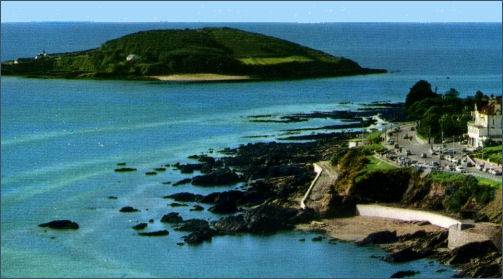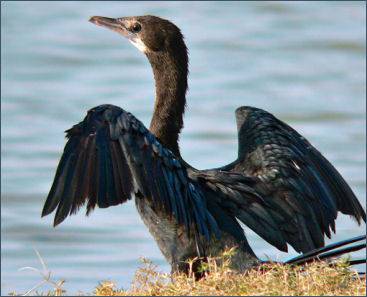Looe Island
OS grid ref:- SX 258 519
 Looe Island, otherwise known as St. George's Island, which lies a mile off the
coast from Looe beach. The island which is known in Cornish as Enys Lann-Managh, meaning island of the monk's enclosure,covers an area of 22.5 acres and is a sanctuary for sea birds.
Looe Island, otherwise known as St. George's Island, which lies a mile off the
coast from Looe beach. The island which is known in Cornish as Enys Lann-Managh, meaning island of the monk's enclosure,covers an area of 22.5 acres and is a sanctuary for sea birds.
The Island has been inhabited since the Iron Age. Roman amphora as well as stone boat anchors and Roman coins. have been discovered there. In the Dark Ages, the island was used a seat of early Christian settlement. A Benedictine chapel was built on the island in 1139 of which only a few stones remain visible. Looe Island became a place of pilgrimage for early Christians.The island was filmed as part of Channel 4's Time Team programme in 2008. A focus of the programme and the excavation was the chapel site at the highest point on the island. The chapel is known as St Michael's and it has been suggested that the island was purchased by Glastonbury Abbey to capitalise on the pilgrim trade relating to the cult of St Michael.
In the seventeenth and eighteenth centuries the island was a popular haunt for smugglers avoiding the revenue cutters out of Plymouth and Falmouth. The Old Guildhall Museum in Looe holds information and research about the smuggling families of Looe Island.
 Looe island was owned by two sisters, Babs and Evelyn Atkins, who wrote two books, 'We Bought An Island' and its sequel 'Tales From Our Cornish Island', which relate the purchase of the island and their experiences living there. Evelyn died in 1997 at the age of 87, Babs continued to live on the island until her death in 2004, at the age of 86. On her death, the island was made a bequest to the Cornwall Wildlife Trust; it will be preserved as a nature reserve in perpetuity.
Looe island was owned by two sisters, Babs and Evelyn Atkins, who wrote two books, 'We Bought An Island' and its sequel 'Tales From Our Cornish Island', which relate the purchase of the island and their experiences living there. Evelyn died in 1997 at the age of 87, Babs continued to live on the island until her death in 2004, at the age of 86. On her death, the island was made a bequest to the Cornwall Wildlife Trust; it will be preserved as a nature reserve in perpetuity.
The island is a marine nature reserve and the waters around it are teeming with life. It provides a quiet haven for wildlife, with a variety of habitats including woodland, maritime grassland, sand, shingle and rocky reef. Warden operated guided walk around the island are around the islande are available. During the three and a half hour visit visitors can you spot island wildlife such as grey seals and great black-backed gulls.
The nature reserve is also home to many nesting birds such as cormorants, shags and oystercatchers. Across the island small wildflower meadows are being created. These areas, combined with the mix of grassland, scrub and woods have allowed numerous moths and butterflies to flourish. Most frequently spotted are speckled wood, meadow brown and red admiral
The island has an extremely mild climate, daffodils there flower at Christmatime and is open to visitors during the summer (a landing fee is payable). At extremely very low spring tides, it can be reached on foot.